From creamy textures to sweet notes, pinpointing the best milk chocolate in the world is no easy feat. With countless milk chocolate brands and varying qualities, which one truly stands out? It’s not just about the taste. It’s also about texture, quality, and its origins.
In this article, I’ll explore these factors and more to uncover the finest milk chocolate in the world. And for full transparency, the rankings may be infused with a touch of my individual taste.
Curious about what makes ‘the best milk chocolate in the world’? These seven below offer some delicious insights.
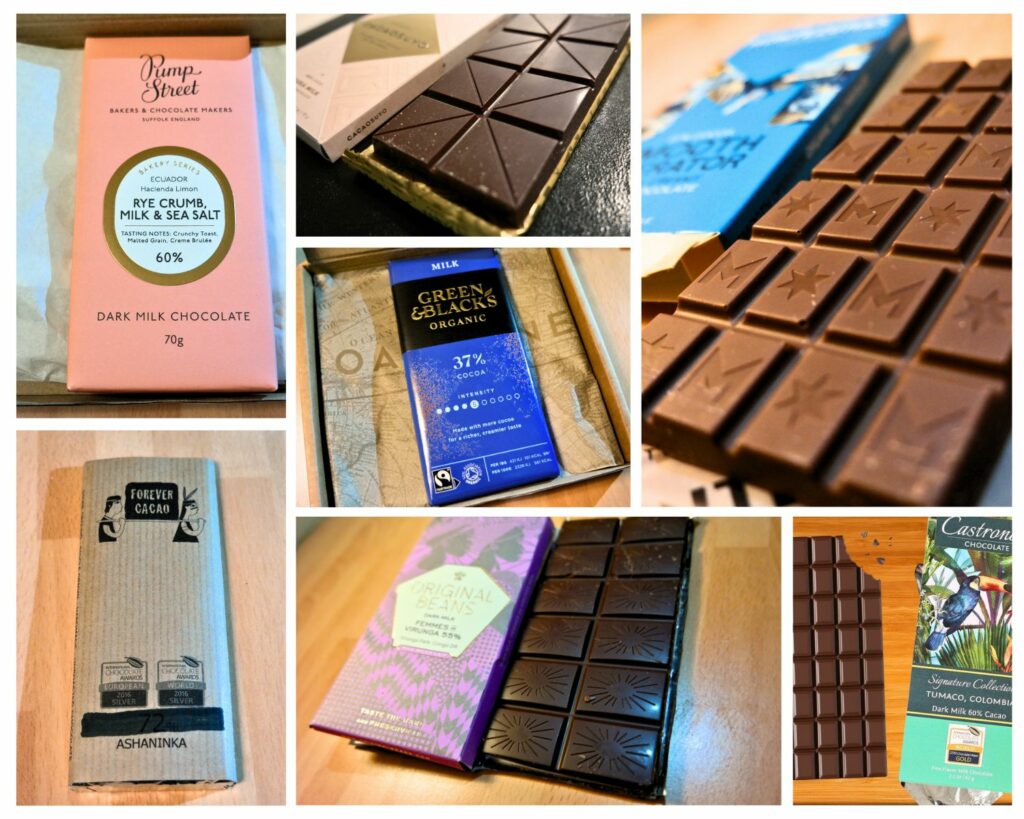
The World’s Finest Milk Chocolates
| Rank | Chocolate Brand | Features & Unique Aspects |
|---|---|---|
| 1 | Cacaosuyo Piura Milk (50% Cocoa) | Special criollo beans, vanilla, unique milk fermenting |
| 2 | Original Beans Femmes de Virunga (55% Cocoa) | Amelonado beans, nutty, cappuccino taste, rare variety |
| 3 | Montezuma’s Milk Chocolate (37% Cocoa) | Dark depth, creamy milk chocolate, innovative blending |
| 4 | Green & Black’s Milk Chocolate (34% Cocoa) | Organic, ethical, rich yet balanced flavor |
| 5 | Castronovo Tumaco, Colombia Dark Milk (60% Cocoa) | Criollo beans, citrus, honey, multiple awards |
| 6 | Forever Cacao Coconut Milk (55% Cocoa) | Vegan, coconut milk, unroasted Criollo, tropical twist |
| 7 | Pump Street Rye Crumb, Milk & Sea Salt (60% Cocoa) | Ecuadorian dark milk, rye crumbs, sea salt, unique texture |
What Exactly is Milk Chocolate?

Diving into the world of chocolates, it quickly becomes clear that not all chocolates are created the same. If you’re on a quest to identify the best milk chocolate, it’s crucial first to understand what sets milk chocolate apart from its counterparts, like dark chocolate or white chocolate.
It seems pretty straightforward—milk chocolate is a chocolate bar that contains milk, but there’s more to it than that.
Core Ingredients of Milk Chocolate
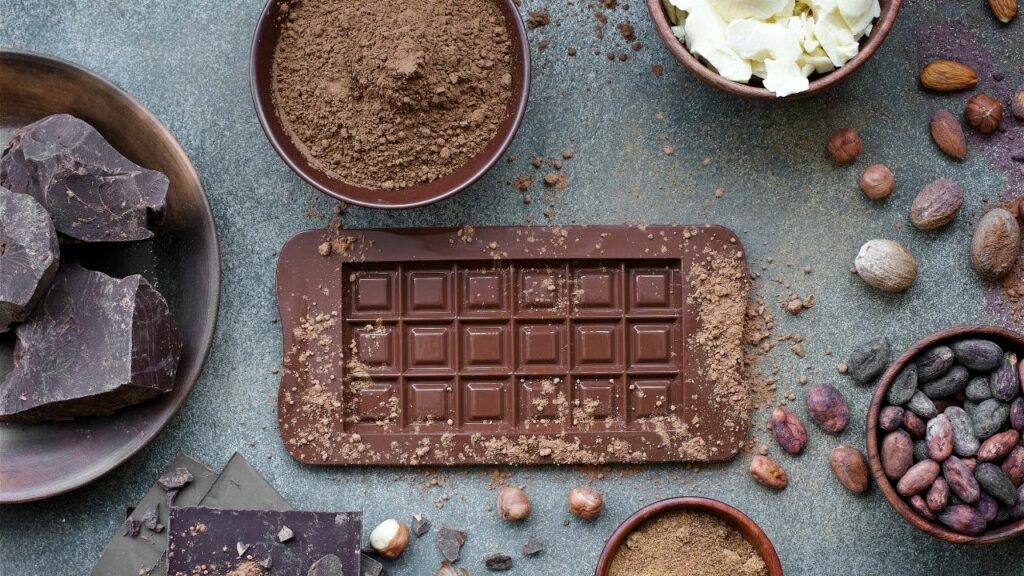
In the United States, milk chocolate is any chocolate prepared “by intimately mixing and grinding cocoa liquor with one or more of the optional dairy ingredients and one or more optional nutritive carbohydrate sweeteners.” [1]
The European Union agrees, considering it “the product obtained from cocoa products, sugars, and milk or milk products.” [2]
In both cases, chocolate liquor and cocoa products refer to the same thing—pure, unaltered paste containing cocoa solids and cocoa butter made by grinding cocoa beans.
In simpler terms, to earn the ‘milk chocolate’ label, a treat must artfully combine cocoa elements with dairy components and sweeteners.
But that’s just the tip of the chocolateberg.
Milk Chocolate vs. Dark Chocolate

The primary distinction between milk chocolate and dark chocolate is the presence of dairy. Milk chocolate contains milk solids or derivatives, giving it a creamier texture and sweeter taste. In contrast, dark chocolate, characterized by its robust cocoa flavor, contains cocoa solids and cocoa butter without any dairy, resulting in a richer and often more bitter flavor profile.
Milk Chocolate vs. White Chocolate
As mentioned, milk chocolate is flavored with cocoa. White chocolate, on the other hand, doesn’t have the cocoa that gives the chocolate flavor. Instead, it’s made with cocoa butter (which is the fat from the cocoa bean and does not taste like cocoa), milk, and sugar. This makes it sweet and creamy, but it doesn’t have the same chocolatey taste as milk chocolate.
And yet, there’s more to the story.
Understanding Ingredient Ratios and Proportions in Chocolate
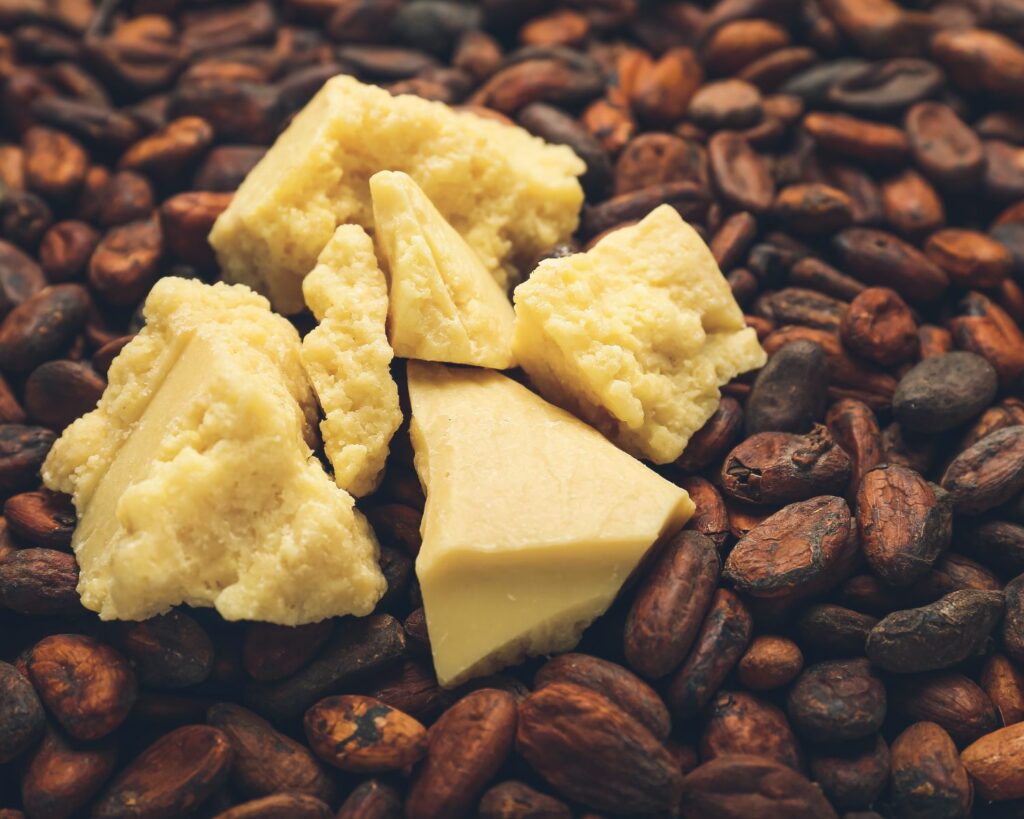
Expert cooks know that you can get two vastly different meals with the same ingredients only by changing the proportions of each. The same happens with milk chocolate—by varying the proportions of cocoa paste, milk, or sugar, you can get two bars that taste nothing alike.
That is why there are international and national regulations meant to set strict terms to define the percentages of each ingredient within milk chocolate bars. It prevents some greedy companies from making products saturated with milk and sugar and without a decent amount of cocoa.
The Food and Agriculture Organization (FAO) specifies that milk chocolate cannot have less than 25% cocoa solids and between 12% and 14% milk solids [3].
However, laws differ in every country—in the United States, cocoa mass has to be a minimum of 10% [1], while the European Union sets the minimum at 30% [2].
If chocolate doesn’t meet the cocoa requirement, it can’t be called “milk chocolate.” It might be labeled as “chocolate-flavored” or “chocolate candy” instead. These rules help ensure that customers know the quality of the chocolate they’re buying.
However, the wide variety of regulations and percentages available means one thing: there is massive room for variety in milk chocolate.
What’s Special About Milk Chocolate?
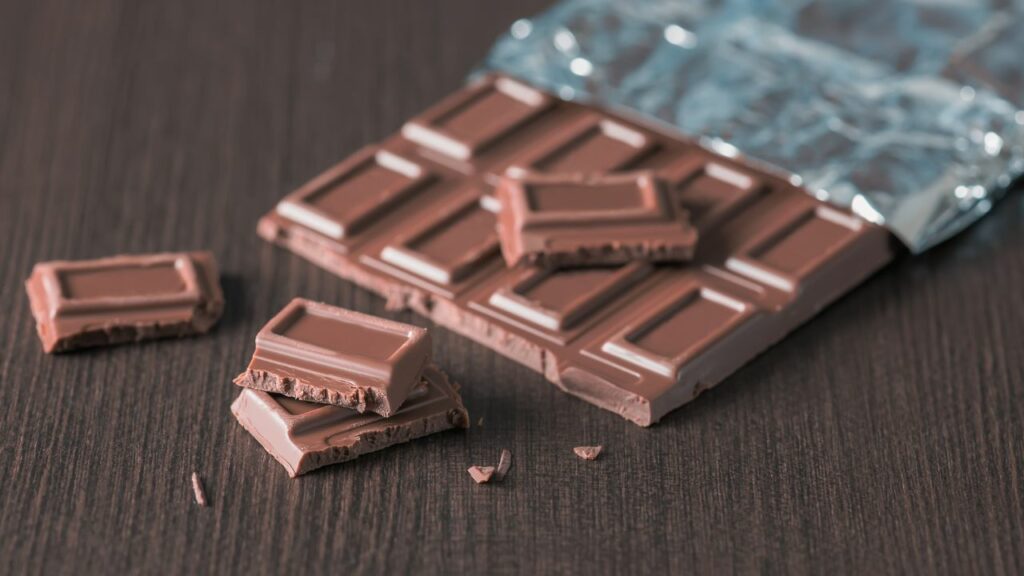
Milk chocolate is the most popular type worldwide, remaining the best-selling variety. The reason is that it’s the most accessible flavor profile—a balanced treat that offers a little bit of everything. Its broad reach makes it a definite crowd-pleaser.
Chocolate expert MacKenzie Rivers, founder of Map Chocolate, owes it to balance.
In an article for the coffee and cocoa magazine Perfect Daily Grind, she states that dairy, cacao butter, and sugar combine to homogenize the different flavors found in cocoa beans, creating a uniform product [4]. In short, milk chocolate combines base ingredients that complement one another.
Milk products add a silky texture and a creamy aftertaste that can smooth out the sharp edges of cocoa. On the other hand, a slight touch of sweetness can reduce cocoa’s natural bitterness and enhance the milky aftertaste. As such, the result is a softer and more accessible chocolate experience.
There is also plenty of variety when it comes to milk chocolate. As I explained before, the percentage of ingredients can affect the type of flavor, meaning that everyone can find a milk chocolate that suits their tastes.
For example, dark milk chocolate has a higher percentage of cocoa still softened by milk solids, and some commercial varieties of milk chocolate have more or less sugar than others.
But even amidst various tastes and preferences, some types of milk chocolate are considered superior. And that happens because certain objective factors affect the quality of milk chocolate.
Factors that Affect The Quality of Milk Chocolate
The more ingredients you add to the mix, the more complex the preparation turns. That’s why milk chocolate is particularly tough to get right.
Chocolatiers are challenged to balance the flavor and textures of cocoa liquor, milk, and sugar. It’s up to their expertise to establish the right bitterness, sweetness, creaminess, or quantity to produce an impeccable final product.
That is why, to find the best milk chocolate in the world, we must look at the two main factors affecting quality: ingredient origins and preparation methods.
1. Cocoa Quality
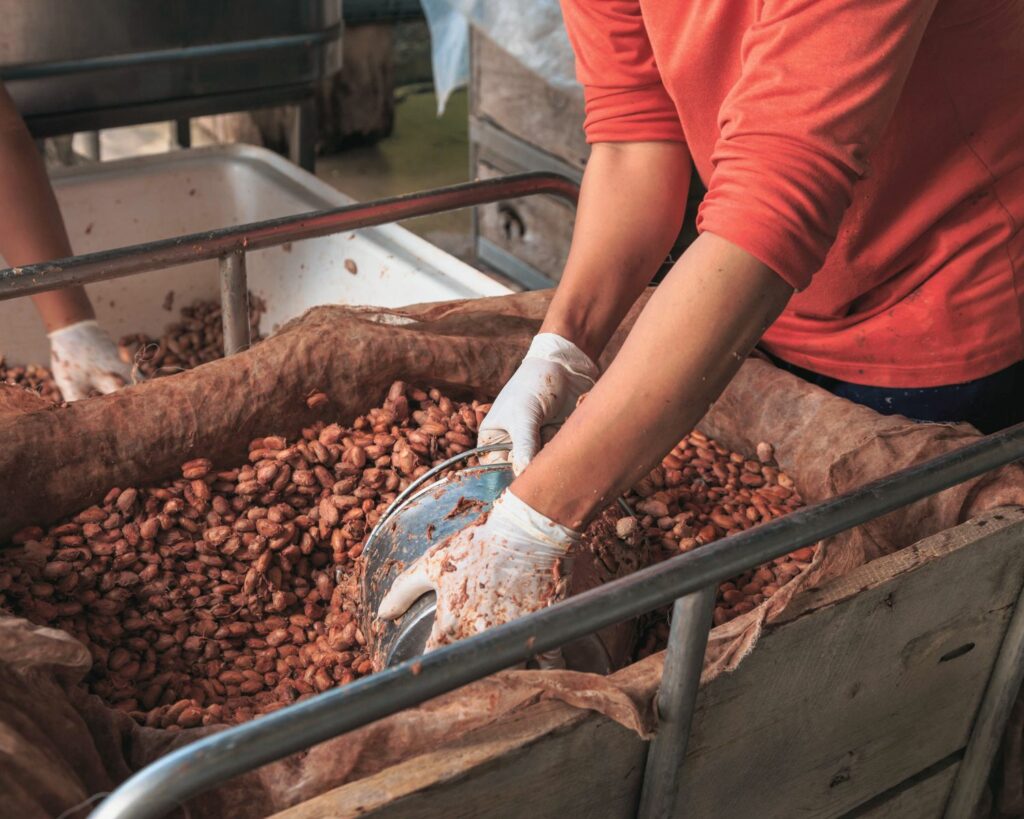
When it comes to chocolate, the most essential ingredient is always the cacao.
Although there are many cacao hybrids and varieties, there are three main types of cacao tree: Criollo, Trinitario, and Forastero, and each of them has a very distinctive flavor and quality.
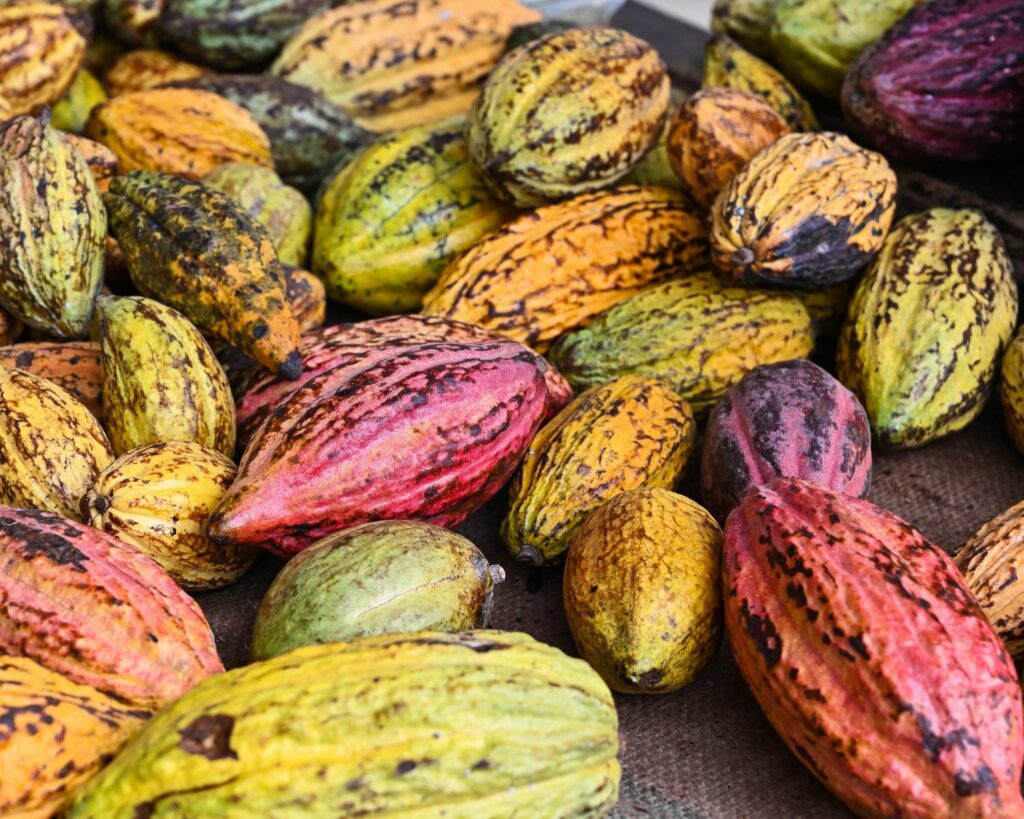
Forastero is a hardy crop that’s easier to maintain but produces a bland flavor, making it the go-to option for mass-produced chocolate. On the other hand, Criollo and Trinitario are rarer and more valuable crops with profound flavors, with Criollo being the favorite of the most exclusive chocolatiers [5].
However, the type of cacao is not the only aspect worth considering. According to chocolatier Laura Schälchli, co-founder of La Flor Chocolate, the quality of cacao beans begins in the soil where the plant grows and continues throughout the entire farming process, shaping the flavor of the chocolate bar before chocolatiers can even start working [5].

Things like the quality of the soil, the nutrients the tree receives, the timing for plucking and harvesting the pods, and the entire transportation process can drastically change the taste of cacao beans. There are also more purposeful methods, such as fermentation techniques, that can change the flavor according to the chocolatiers’ wants.
2. Milk Quality
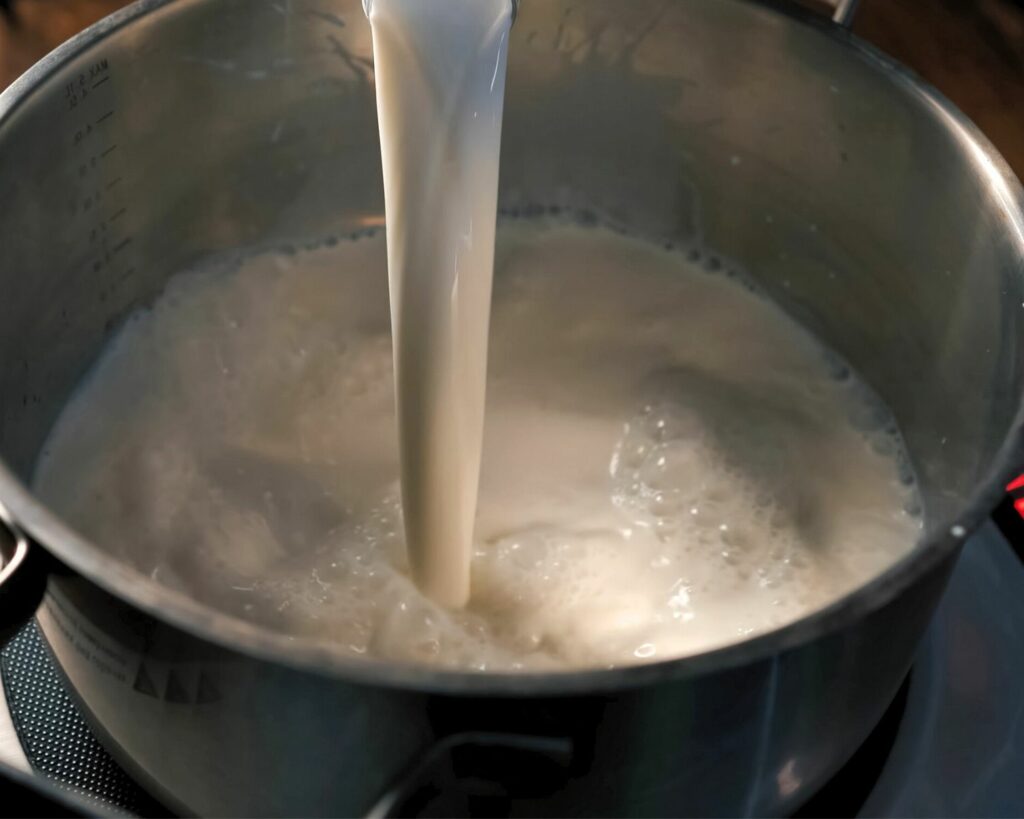
The type of milk used in chocolate can make or break the preparation.
Schälchli explains that fresh milk has moisture, and moisture and chocolate don’t go together. As such, they have to use milk powder to add dairy flavor without the water content [5].
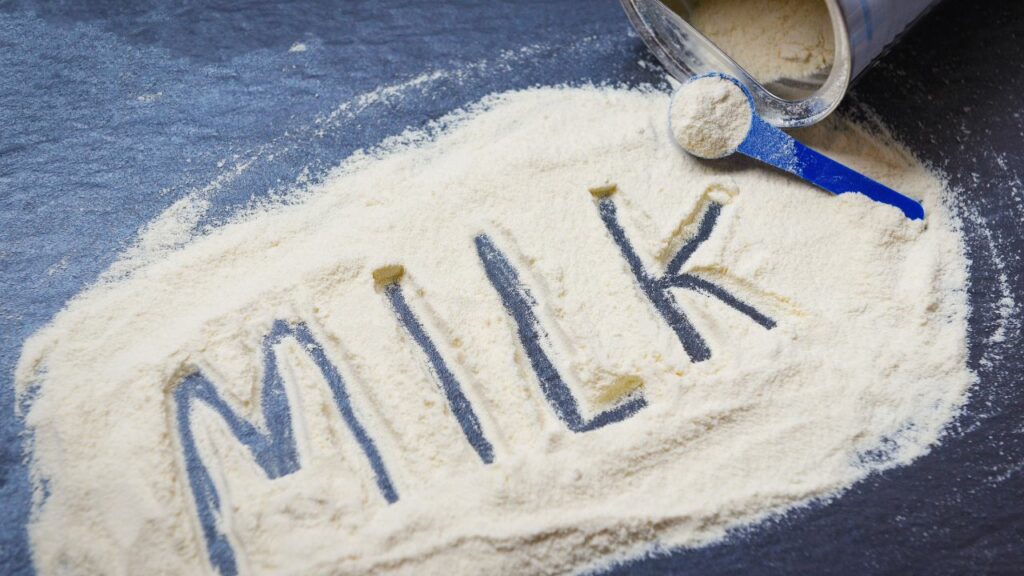
Chocolate expert Stephanie Greiner adds to this input, specifying that the fame of Swiss chocolate comes down to the high quality of their Alpine cows and how some of the most exclusive and renowned chocolatiers own the cow whose milk they use for their creations [5]. In this manner, they can monitor the cow’s diet and the quality of the milk every step of the way.
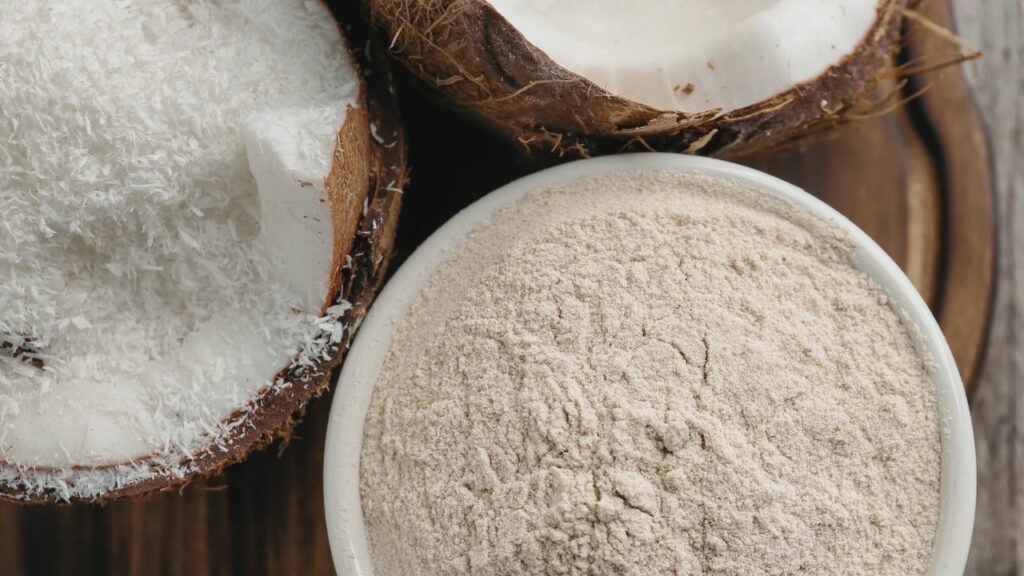
However, milk products are not the only option. Lately, there has been a rise in the use of alternative milk products for dairy-free, high-quality milk chocolate. James Walter, founder of Seed Chocolate, explains that some “craft chocolate makers are using other milk- and lactose-free powders, the most current being coconut and rice powders.” [4]
3. Chocolate Preparation Methods and Techniques

Preparing milk chocolate follows basic steps: roast the cocoa nibs after removing the shell, grind them to create chocolate liquor, and incorporate milk powder, sugar, and cocoa butter.
However, the difference between basic milk chocolate and the best milk chocolate in the world lies in the details of each step in the process. Not only do the proportions of each ingredient vary wildly, but all famous chocolatiers have specific and secret methods they protect.
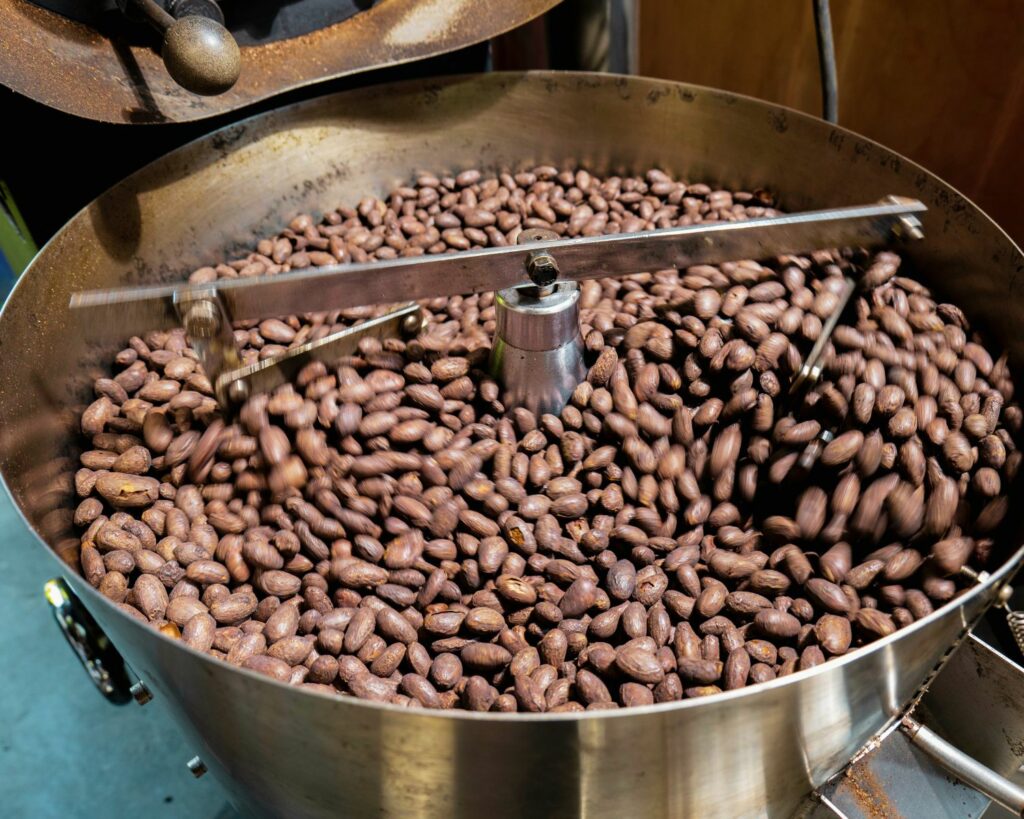
Roasting the cocoa nibs, for example, has many nuances. Chocolatier Schälchli explains that there are many roasting profiles and techniques according to the recipe: different temperatures and roasting times create different flavors [5].
Likewise, conching—mixing air into the chocolate paste so it loses acidity—changes from brand to brand, with some blending the ingredients for hours and others for several days.
Choosing the Best Milk Chocolate In The World: Key Considerations
Understanding the nuances of milk chocolate ingredients and preparation is essential to know the critical aspects behind chocolate quality. However, as a consumer, you cannot know the details of the behind-the-scenes process.
That’s why the key to finding the best milk chocolate bar in the world ultimately comes down to your experience. Rest assured—I have a list of what users can look for to find the best milk chocolate in the world.
1. Sustainability and Ethics
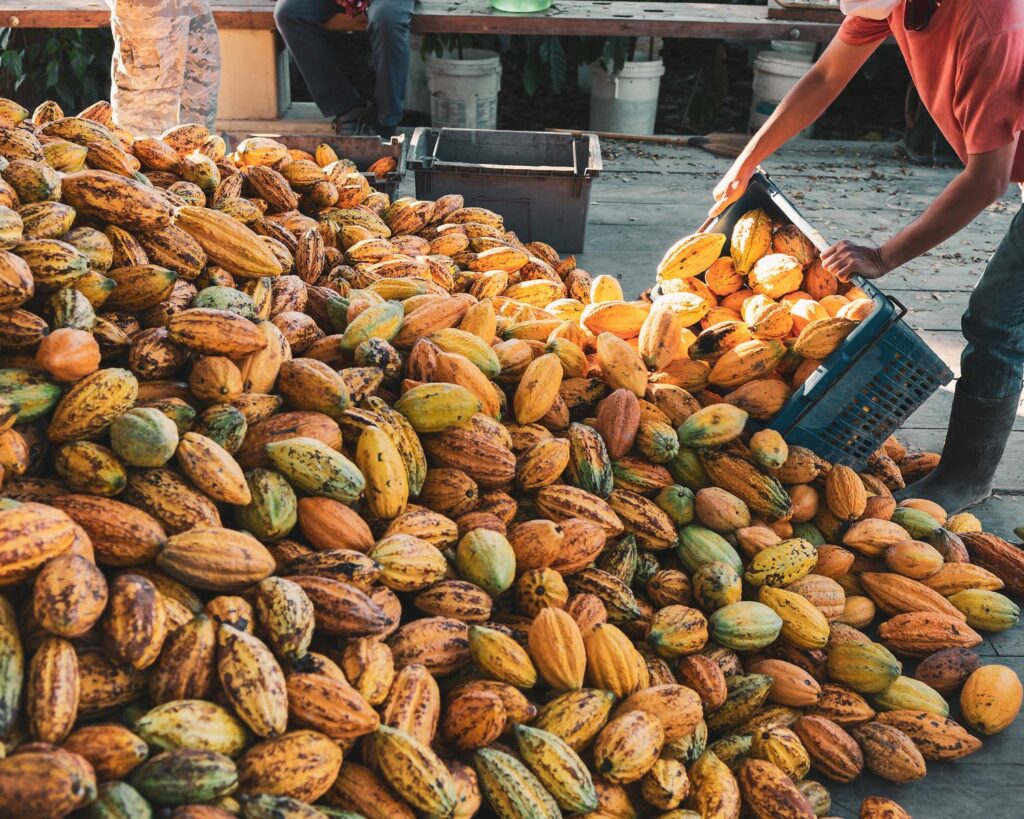
The best milk chocolate in the world is one that does not exploit.
Historically, chocolate production has been plagued by various ethical concerns—colonialism, poverty, child exploitation, slave labor, deforestation, and more. Since most cacao products come from Latin America and Africa, these regions are particularly vulnerable to abuse within the industry.
Ethical, sustainable, and fair trade milk chocolate guarantees an equitable profit distribution where farmers receive the payment they deserve without damaging the ecosystem.
Not only does this ensure justice across the board during chocolate production, but it also ensures happy workers and high-quality products.
2. Appearance
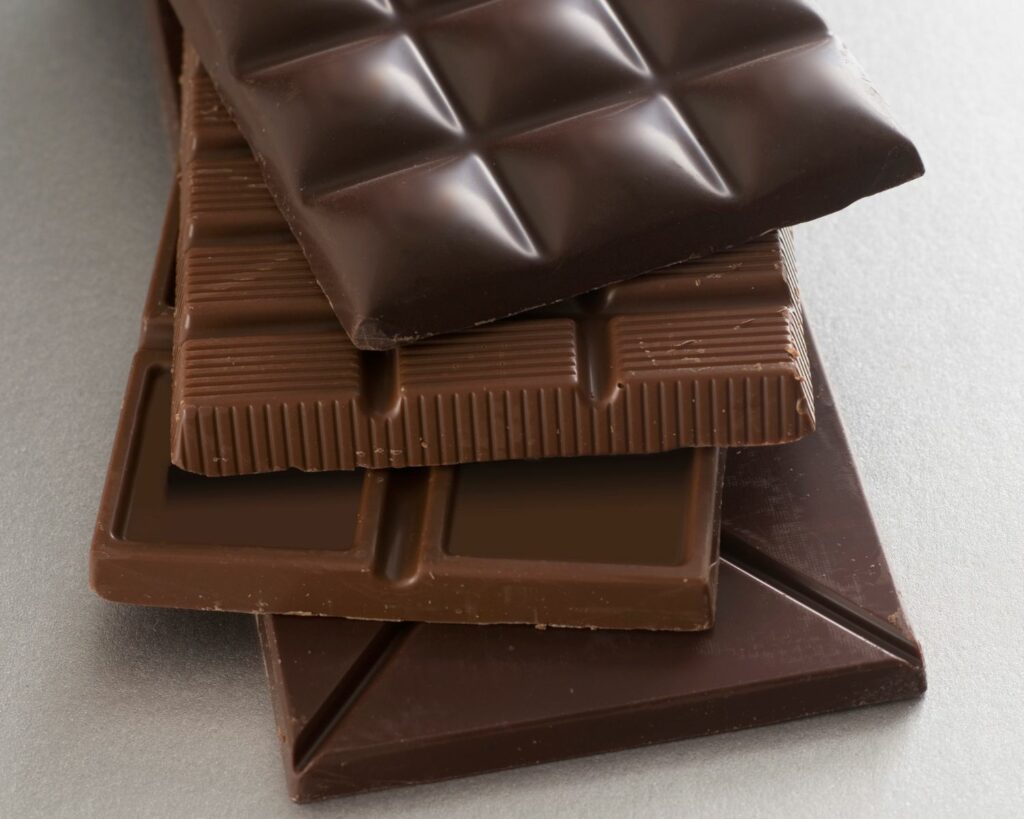
Despite what you might think, a darker or lighter color does not signal the quality of a milk chocolate bar. Dark milk chocolate will have a richer brown color due to its higher cacao content, but that does not mean a lighter-colored chocolate bar is not just as exquisitely prepared.
Instead, what you should look for is a smooth or rough appearance. A smooth-looking bar doesn’t show coarse edges when snapped, indicating finely ground cocoa beans with a more careful manufacturing process.
3. Mouthfeel & Texture

The grind of the cocoa nibs to create the chocolate liquor can also affect texture and mouthfeel. As chocolatier Amy Guittard explains, “If you’re refining on a shorter period of time, your grain or your particle size is going to be larger,” which leads to an uneven melting as you taste it, creating a coarser experience [6].
In contrast, a bar of high-quality chocolate would have a careful grinding process that creates fine particles evenly coated by the cocoa butter, resulting in that distinctive melt-in-your-mouth texture.
4. Taste

While the actual flavor of milk chocolate bars varies immensely between brands and styles, a genuine, high-quality product will have flavor depth and complexity.
Regardless of your preferences, a good milk chocolate bar should not taste like sugar first and foremost—a clear signal that there is more sugar than cocoa. Sugar is the cheapest ingredient in the mixture, so brands looking for quantity over quality will rely on it.
The best milk chocolate bars have complex flavor notes that bring cocoa first and foremost. Depending on the brand, you should taste the cocoa’s earthy, nutty, floral, or berry notes. Milk quality should be evident, with a rich and creamy dairy flavor rather than watered down.
The 7 World’s Finest Milk Chocolates That Redefine Indulgence

Alright, finally, let’s talk chocolate. We’ve all had that standard store-bought bar, and sure, they’re okay. But then there are those chocolates that just…wow you. The ones I’m about to share below? They’re in a league of their own. Why? Because it’s not just about the melt-in-your-mouth goodness (though, trust me, they’ve nailed that).
These brands have gone the extra mile. They focus on quality ingredients, sourced responsibly. They’ve got the awards and recognition to back up their quality. And then there are the unique flavor profiles – from hints of vanilla to zesty citrus notes.
Having tried way too many chocolates than I’d like to admit, these have given me moments of pure joy. So, when I say these are some of the best milk chocolates in the world, it’s because they truly offer an experience, not just a snack.
Without further ado, here are the 7 best milk chocolates in the world:
1. Cacaosuyo Piura Milk

I would definitely place the Cacaosuyo Piura Milk Chocolate first on the list. It is a remarkable chocolate that has gained international recognition, including the International Chocolate Awards.
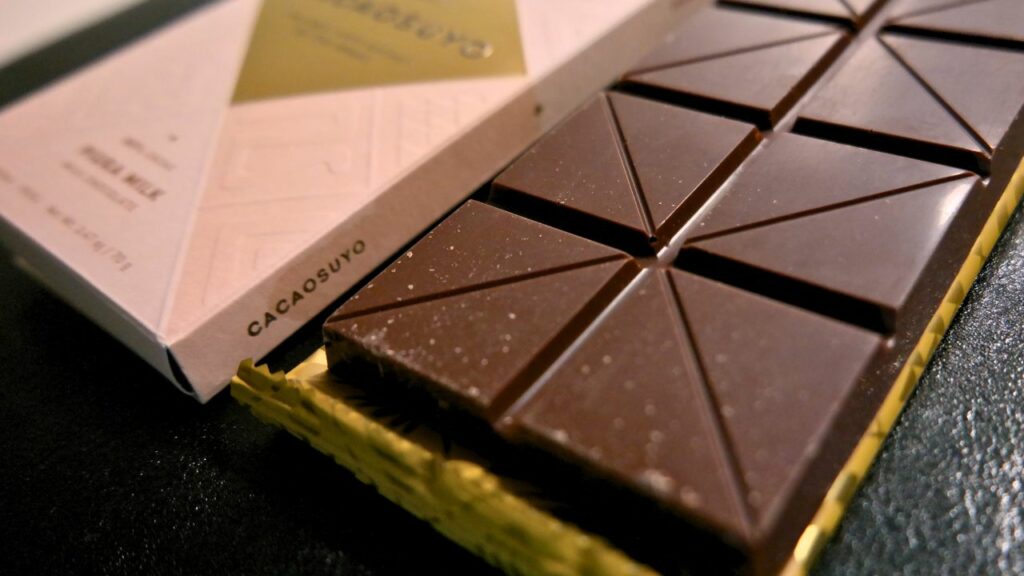
It’s produced entirely in Peru, showcasing the expertise of local farmers and chocolatiers. A unique feature of this chocolate is its use of special criollo cacao beans, which impart a subtle vanilla flavor, distinct from typical milk chocolates.
Another key aspect of this chocolate is its milk fermentation process. This soft fermenting approach adds a zesty touch to the chocolate, creating a balance that’s not usually found in traditional milk chocolate. It’s an innovative approach that enhances the overall taste profile, blending sweetness with a hint of zest.
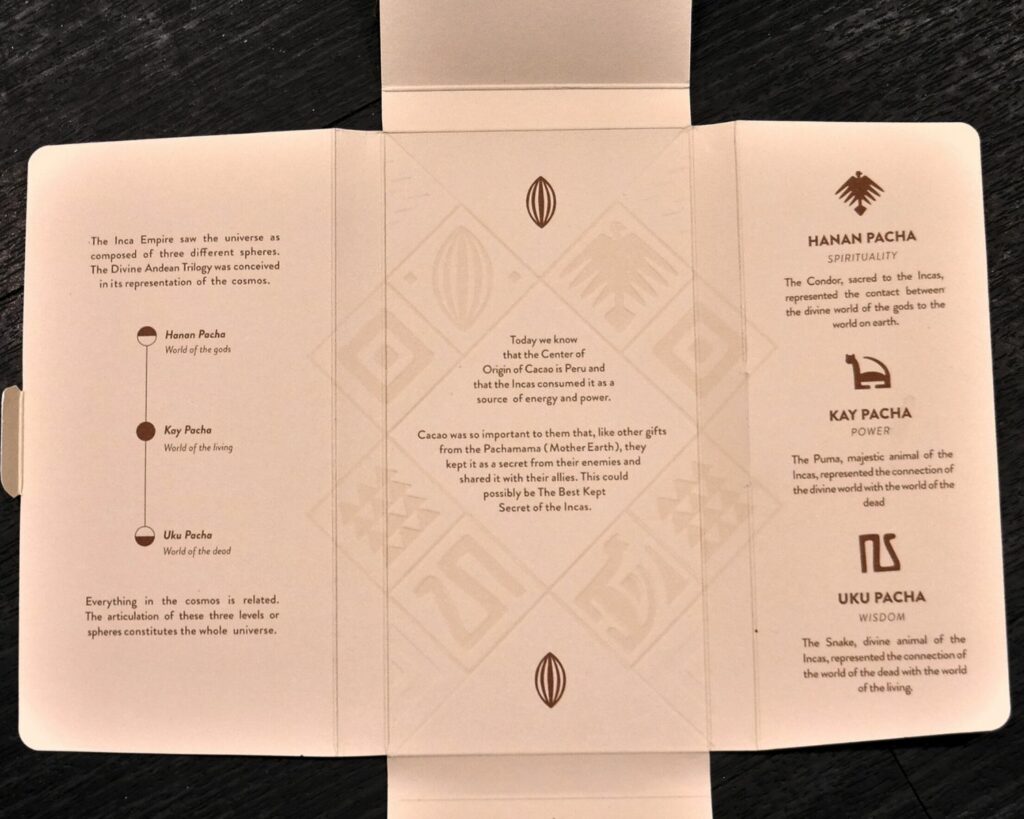
From my own tasting experience, Cacaosuyo Piura milk chocolate was unexpectedly delightful. When I first tried it, the vanilla notes immediately stood out, offering a new depth to the milk chocolate flavor I was used to. The zesty twist, a result of the unique milk treatment, certainly added an interesting layer to the taste that I really liked.
Do, I must say, this is not just a regular sweet chocolate; it has a complexity that makes each bite more engaging. When tasting it, it kind of felt like a glimpse into Peru’s rich cacao culture, where each piece offered a taste of the country’s diverse flavors.
2. Original Beans Femmes de Virunga
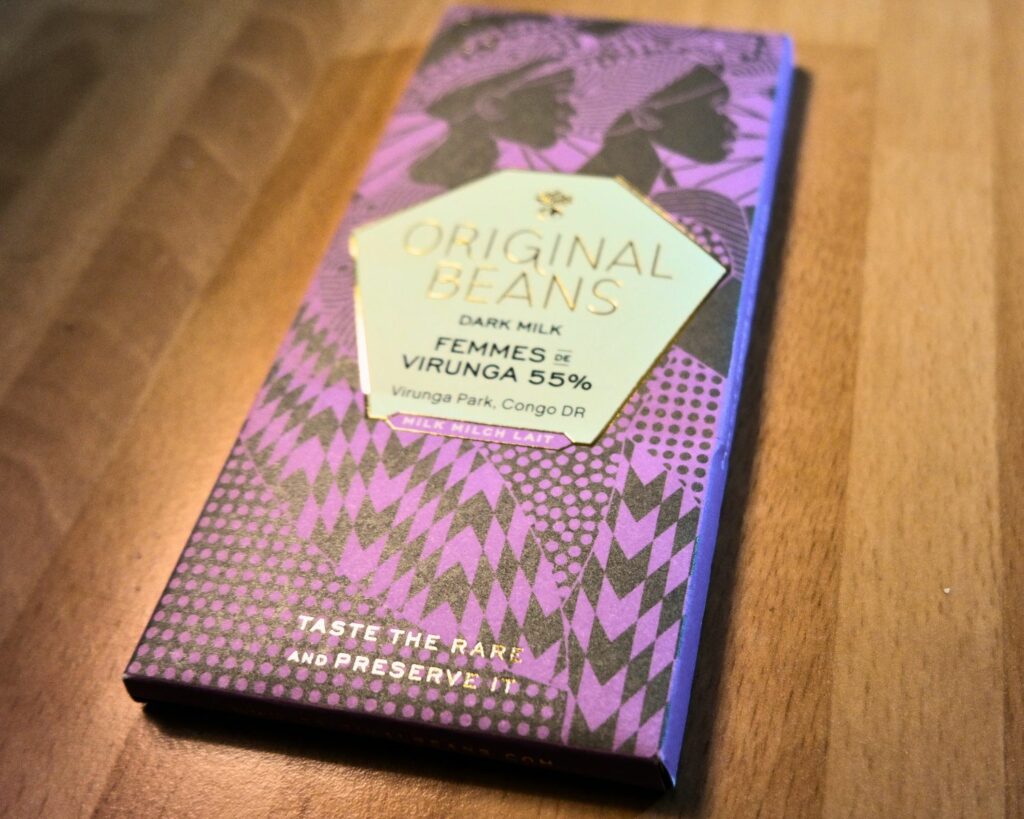
Original Beans Femmes de Virunga 55% dark milk chocolate is a delight for the senses. It’s made from rare Amelonado cacao beans, offering a unique flavor blend. The chocolate boasts a deep roasted nut taste, enriched with a sophisticated cappuccino aftertaste and smooth caramel notes.
When I first tried this chocolate, its flavor depth impressed me. The robust roasted nut taste immediately stood out, followed by a rich cappuccino note. The smooth caramel finish was the perfect complement, making each bite a luxurious experience.
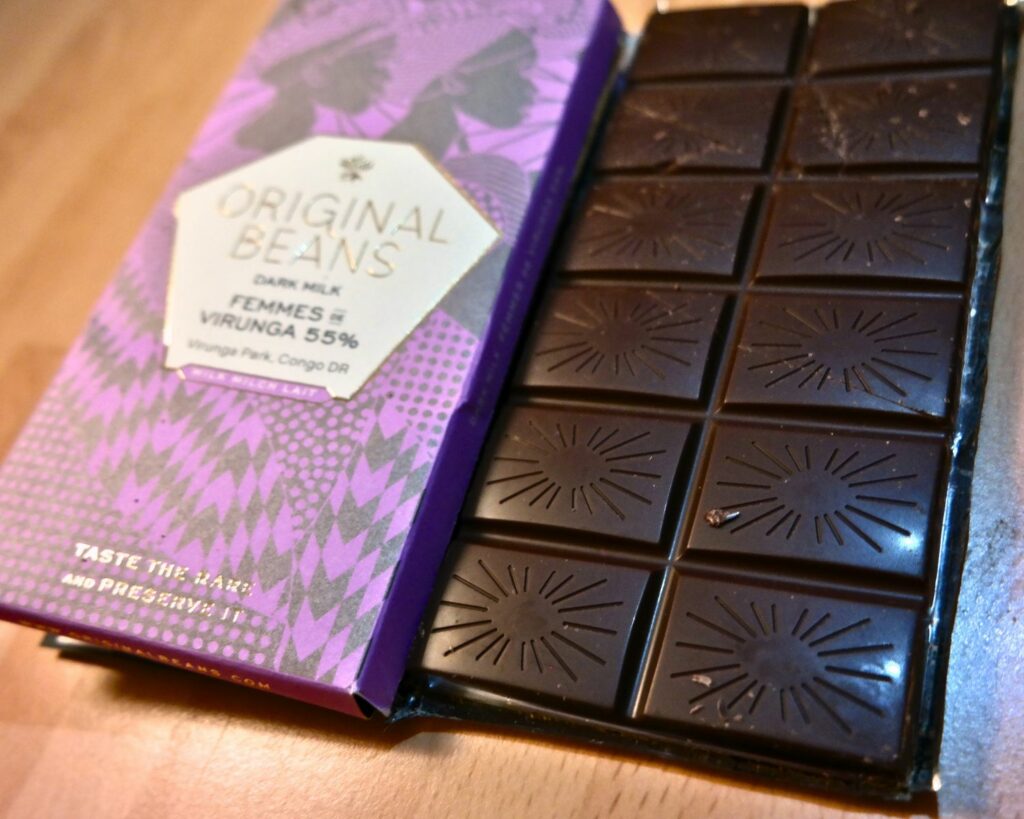
The texture of this chocolate adds to its appeal. It’s creamy and melts smoothly, enhancing the rich flavors. This chocolate quickly became a favorite for its combination of exquisite taste and velvety texture, ideal for when I crave something indulgent and distinctive.
3. Montezuma’s Milk Chocolate
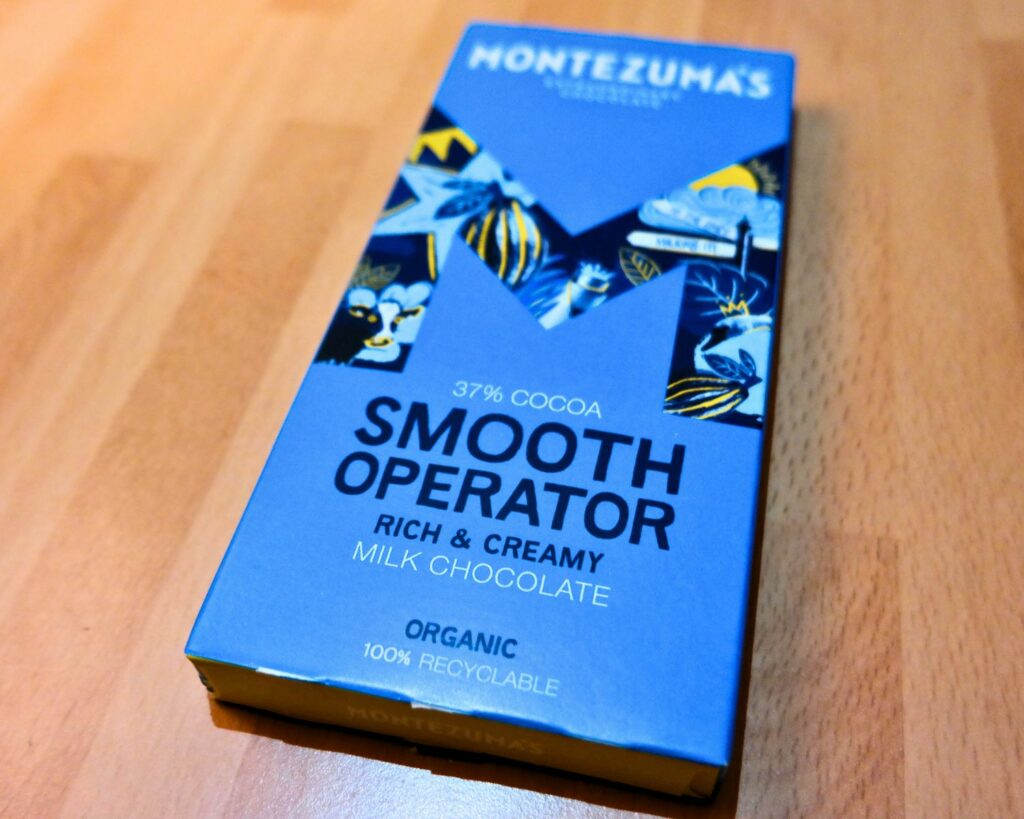
British company, Montezuma initially began as a small family operation, crafting chocolate products by hand. They quickly gained a reputation for their innovative and unique flavors, as well as their commitment to using ethically sourced ingredients.
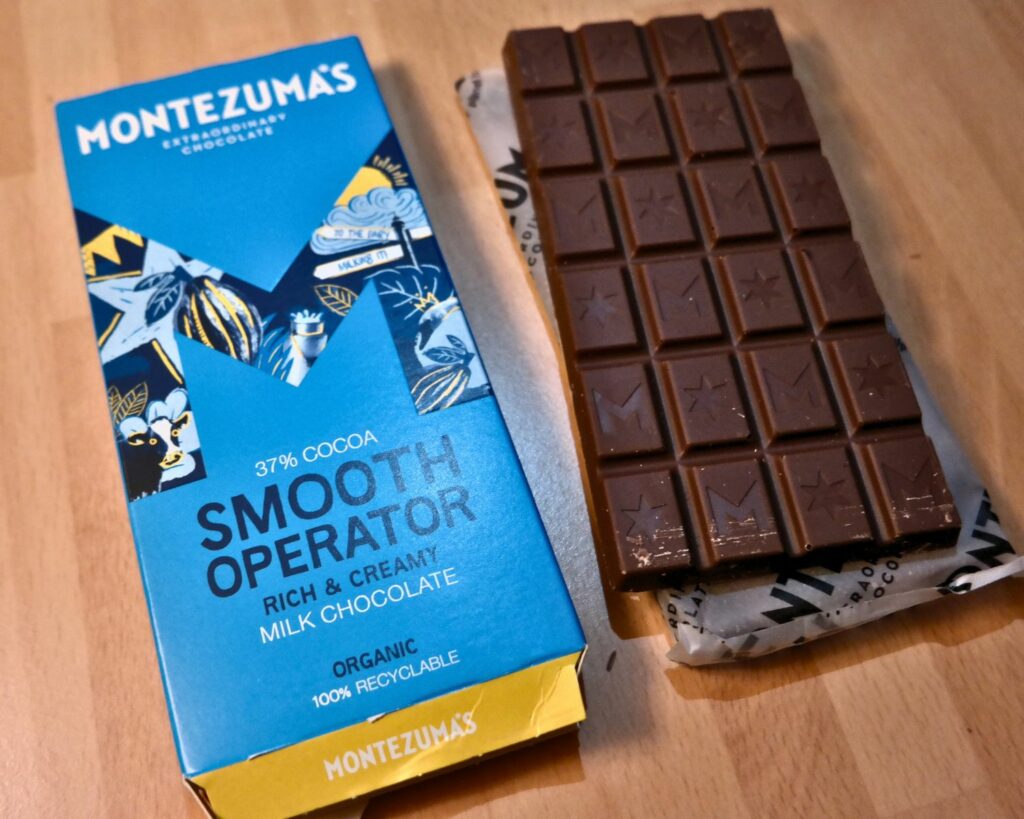
The company is known for its creativity in chocolate making and its unique blend of rich, dark chocolate depth classic milk chocolate creaminess, and silky smooth texture.
Ethical chocolate lovers particularly appreciate its commitment to organic ingredients and recyclable packaging, making it not just a treat for the palate but also a responsible choice.
In my opinion, Montezuma’s milk chocolate is a delightful paradox. It combines the depth of dark chocolate with the creaminess of milk chocolate, which is a rare find. The 51% cocoa content hits the sweet spot for me. And I really admire their commitment to organic ingredients and eco-friendly packaging. It’s like enjoying a bit of dark chocolate without any of the guilt. But still, it is sweet enough to make you want to keep an eye on how much you’re having!
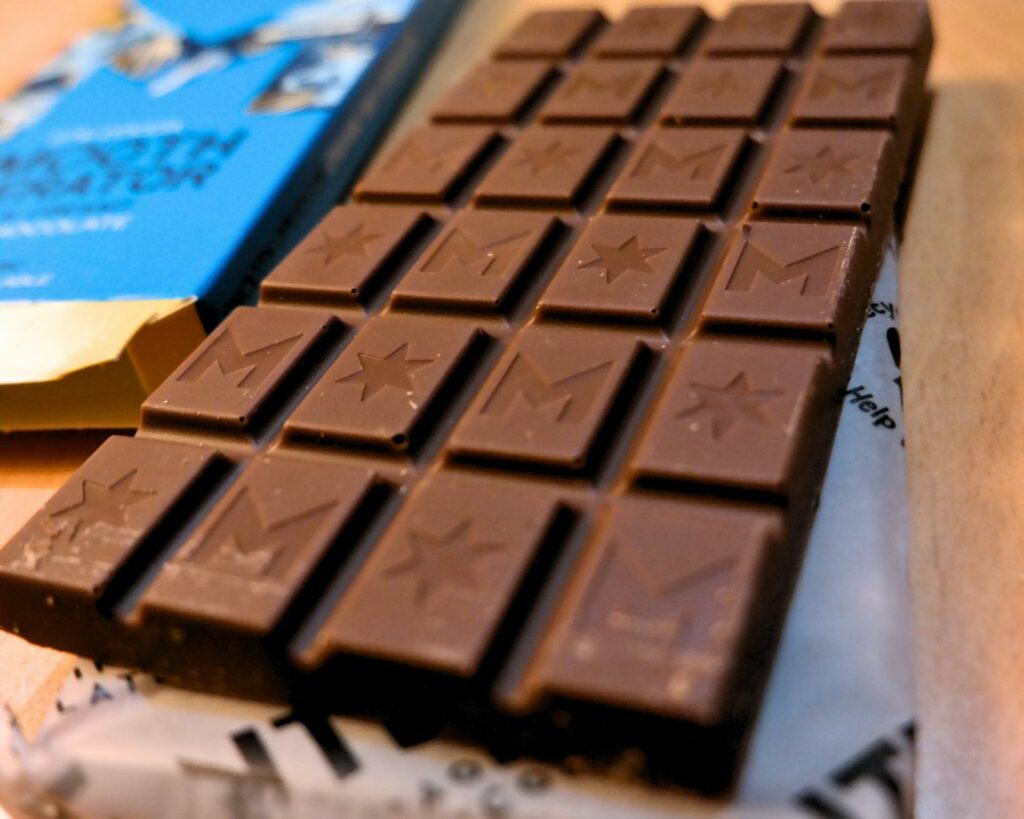
And yes, the texture is silky smooth, melting perfectly in your mouth.
In short, Montezuma’s isn’t just a treat; it’s an experience that sets a new standard for what milk chocolate can be. Give it a try, and you might just find it redefines your chocolate preferences!
4. Green & Black’s Milk Chocolate
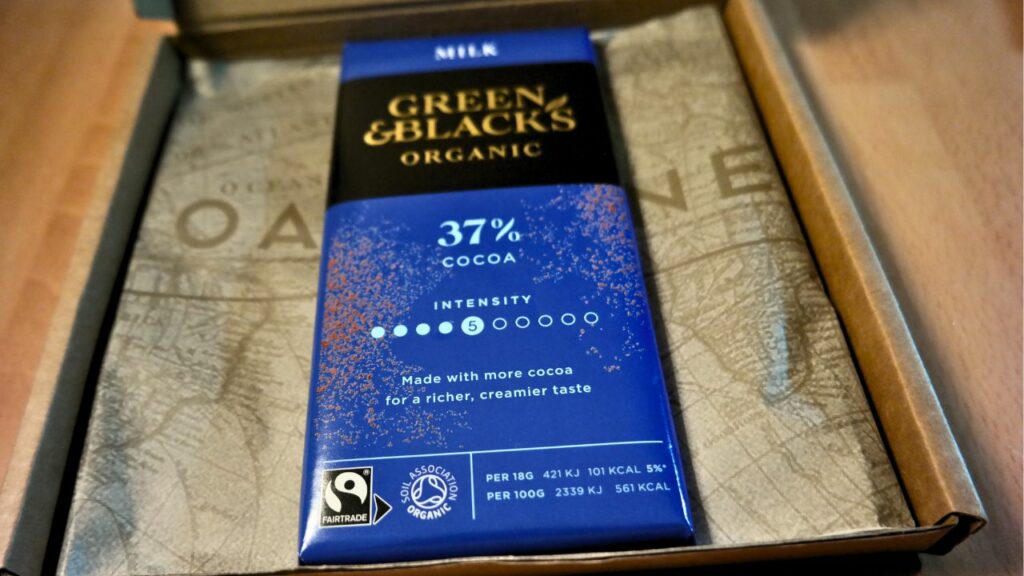
Yes, Green & Black’s Milk Chocolate quite stands out in this list, particularly because of its lover 34% cocoa content compared to the other contestants. This percentage is interesting because it’s slightly lower than what you might find in other high-quality milk chocolates, which often range between 35% to 60% cocoa. Yet, despite being on the lower end of this spectrum, this chocolate manages to deliver a rich and satisfying flavor.
It’s a testament to how Green & Black has crafted a balance that brings out a deep, chocolatey taste without being too overpowering, which is what you might expect with higher cocoa content.
What draws me to Green & Black’s is this nuanced approach to milk chocolate. It’s a delightful middle ground – offering a richer experience than your ‘standard milk chocolate’, but without the intensity of dark chocolate. The creamy texture complements this balance, making each piece a smooth and enjoyable experience.

Also, the commitment to organic and ethical production adds value to each bite, knowing that it’s a more sustainable choice.
Oh, I’ve known Green & Black’s milk chocolate for ages. It’s been one of my regular picks since you can find it in most supermarkets pretty easily. Lately, though, I’ve started to lean more towards chocolates with a higher cocoa content.
But Green & Black’s, it’s been a long-standing favorite, not just for me but for my kids as well. It’s got this ideal balance, right? Some of the higher cocoa ones are too much on the dark chocolate side for the kids’ taste. Green & Black’s, though, it’s just right – rich in flavor but not overly so. It’s a fantastic choice for anyone who prefers their milk chocolate with a bit more of that milky smoothness.
5. Castronovo Signature Collection – Tumaco, Colombia Dark Milk 60%.
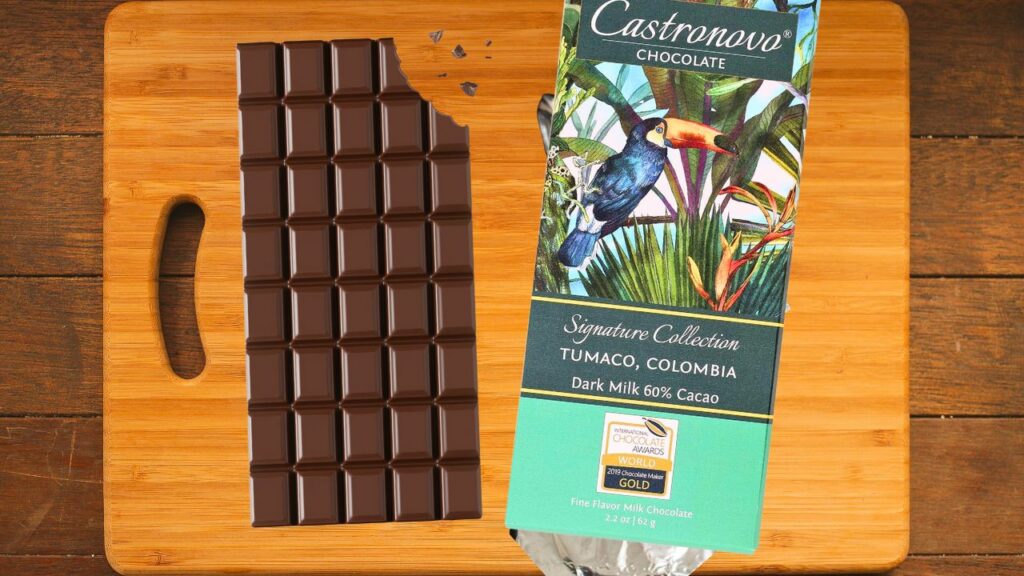
Castronovo Signature Collection – Tumaco, Colombia Dark Milk 60% stands out in the world of fine chocolates. It has garnered over eight prestigious awards, highlighting its exceptional quality. This chocolate is crafted from the finest Criollo cacao beans sourced from Tumaco, Colombia.
The flavor profile of this chocolate is both complex and delightful. It features distinct notes of citrus and honey, creating a rich taste experience. A subtle floral aftertaste follows, adding an extra layer of sophistication.
And I must say, the texture of the chocolate is as impressive as its flavor. Creamy dairy elements gently temper the intensity of the chocolate. This results in a perfect balance that is both rich and elegant.
I stumbled upon this chocolate quite by chance at a local gourmet store. Initially, I was drawn in by its artful packaging, but it was the first bite that really made an impression.
The milk chocolate was smoother and creamier than any I’d had before, and the subtle hints of citrus and honey were a delightful surprise.
It wasn’t just the flavors, but the way they lingered on the palate, creating a lasting, cozy feeling. This chocolate quickly became more than just a treat; it turned into a small luxury I’d look forward to after a long week.
6. Forever Cacao 55% Coconut Milk
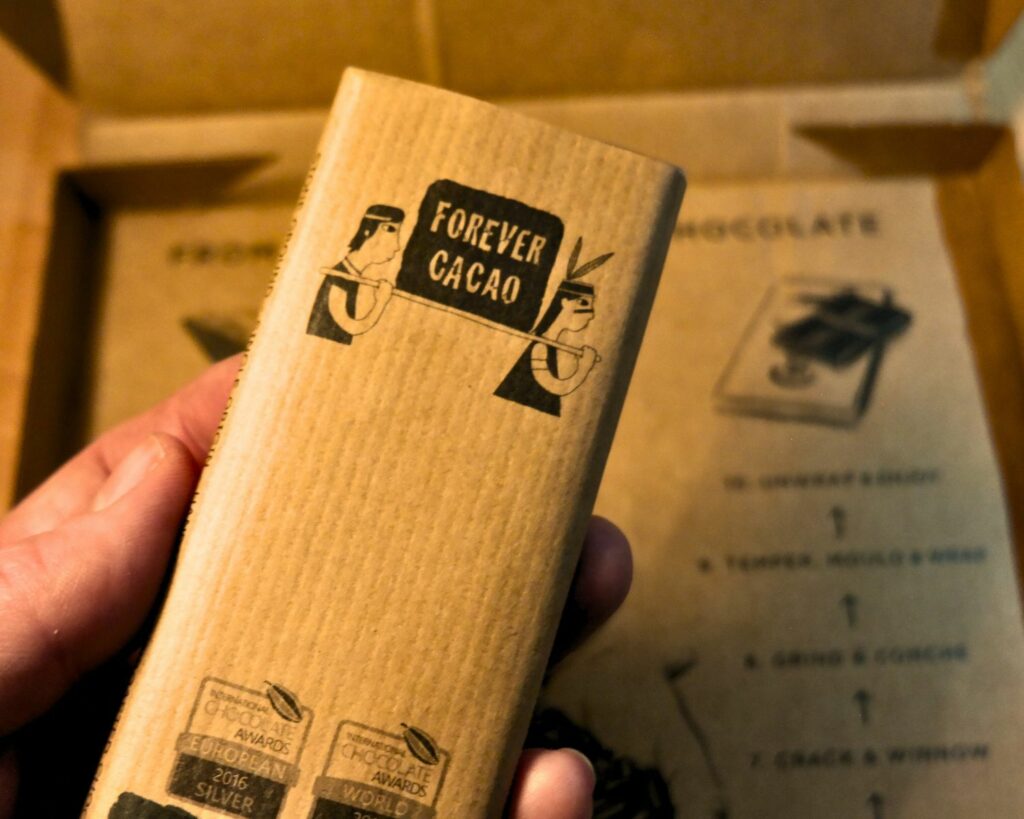
Forever Cacao’s 55% Coconut Milk chocolate is an excellent choice for those with specific dietary needs. It’s vegan, gluten-free, and dairy-free, making it a versatile option for various preferences. The standout feature of this chocolate is its use of coconut milk powder. This ingredient lends the chocolate distinct tropical notes and a subtle nutty aftertaste, offering a unique twist to the milk chocolate flavor profile.
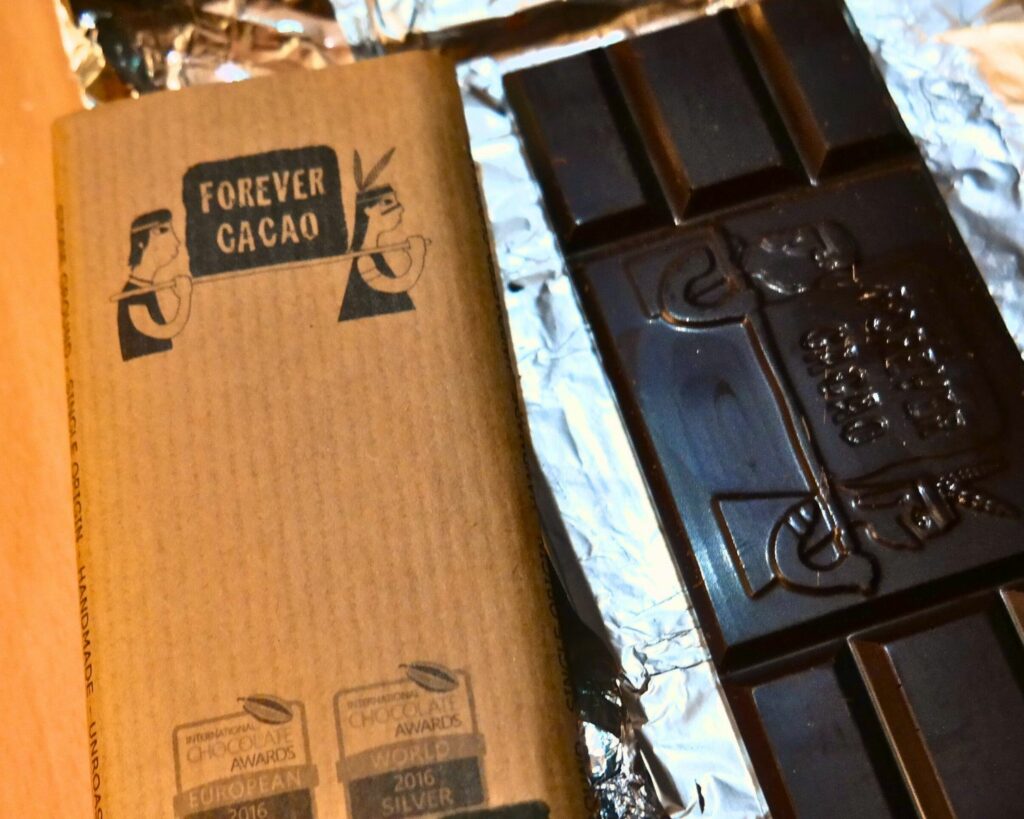
The combination of coconut milk powder with unroasted Criollo beans from Peru is what truly defines this chocolate. The Criollo beans, known for their high quality, contribute to a rich and satisfying flavor. This blend is especially appealing to those seeking dairy-free chocolate alternatives.
Ethically sourced and consciously made, Forever Cacao’s 55% coconut milk bar is a top choice for anyone looking for vegan, gluten-free, and dairy-free milk chocolate. Its distinct taste profile, combining tropical and nutty notes, makes it a unique and enjoyable treat.
When I first tried Forever Cacao’s 55% Coconut Milk chocolate, it was a refreshing change from traditional milk chocolates. The coconut milk powder added an intriguing tropical twist that I hadn’t encountered before. The nutty aftertaste complemented the unroasted Criollo beans perfectly, making it a memorable chocolate experience. It quickly became a favored option for me, especially when I’m in the mood for something different in the realm of milk chocolates.
7. Pump Street Chocolate 60% Rye Crumb, Milk & Sea Salt
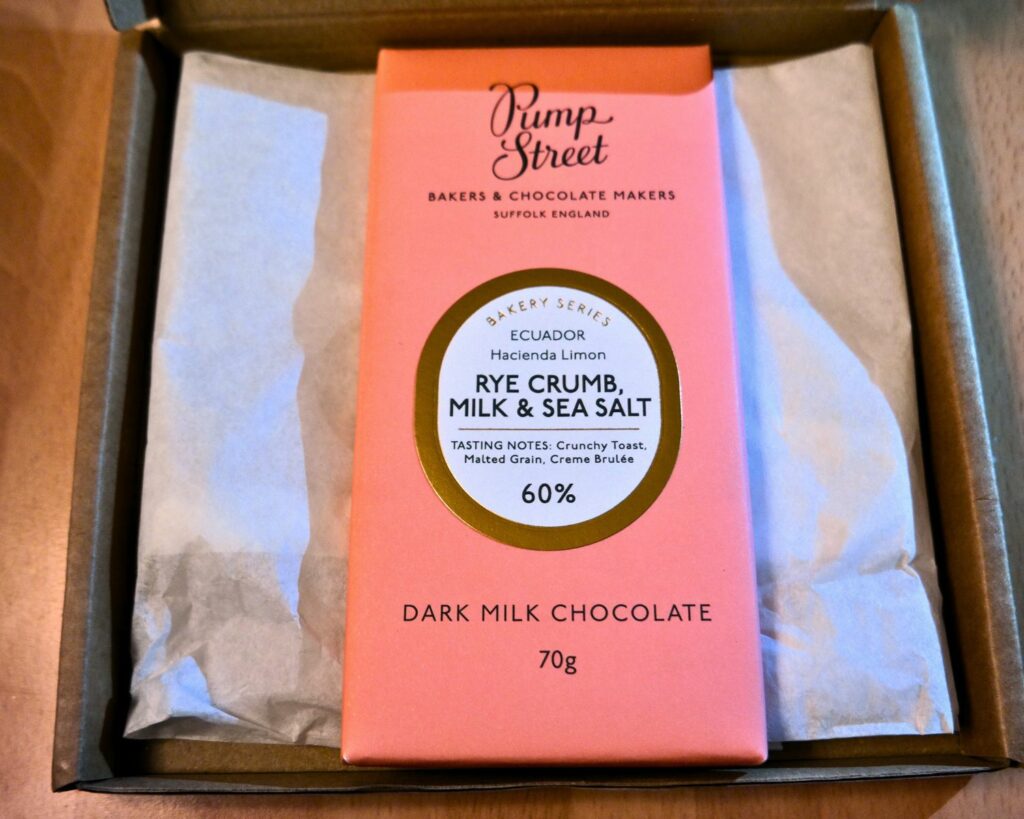
Pump Street’s 60% Rye Crumb, Milk & Sea Salt chocolate isn’t just any chocolate bar – it’s a masterpiece that’s earned its stripes in the world of fine chocolates. It’s bagged the Academy of Chocolate 2021 Gold for Milk Bean to Bar Flavoured, the 2015 Gold for Best Flavoured Milk Chocolate Bar, and two Gold Stars at the Great Taste Awards 2015. Handcrafted in Suffolk, UK, from the grinding of the flour to the making of the bar, it truly stands as a testament to the art of chocolate making.
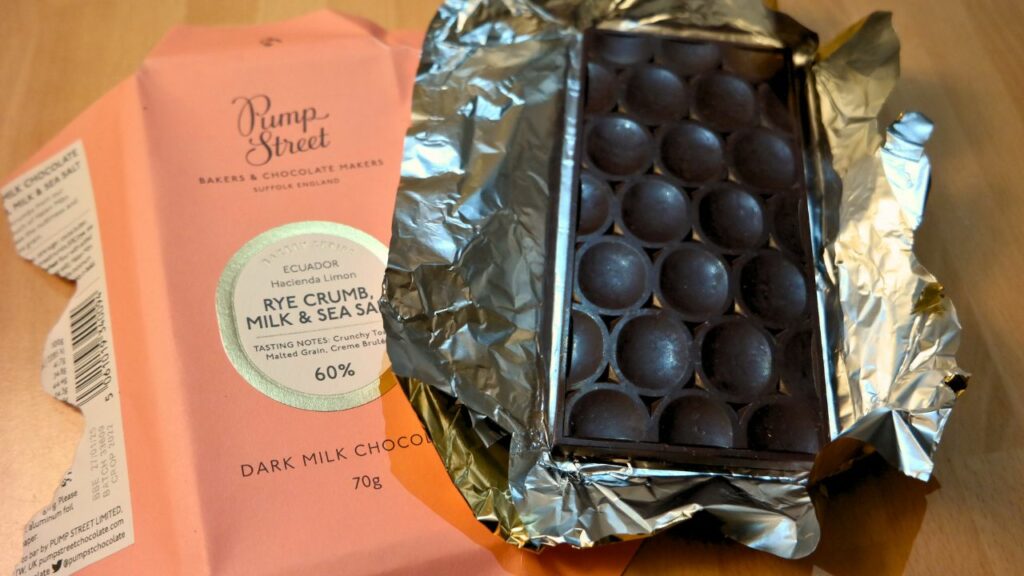
The unique blend of crunchy rye crumbs, and a hint of Halen Môn sea salt, combined with the rich Ecuadorian 60% Dark Milk chocolate, creates an exquisite balance. The rye brings out a nutty and slightly acidic flavor that contrasts beautifully with the mellow creaminess of the milk chocolate.
What sets this chocolate apart is its intriguing texture. The rye crumb adds a distinctive crunch that’s entirely unique, and the subtle sea salt enhances the overall experience. The chocolate owes its deep, nutty, and caramel-like flavors to the Arriba Nacional beans, making it a delight for anyone who appreciates innovative chocolate creations.
For those who love experimental flavors, this chocolate is a hit. Its ingenious addition of rye crumb for texture and the clever pairing with sea salt result in a layered tasting experience that’s hard to forget.
I remember the first time I unwrapped a bar of Pump Street’s Rye Crumb chocolate. The scent of rich cocoa mixed with a hint of sea salt was alluring. But the magic really happened at the first bite: the unexpected crunch of the rye was a perfect complement to the silky milk chocolate, creating an interplay of flavors and textures that transformed it from just a chocolate bar into a memorable experience.
In Conclusion
These are undoubtedly some of the best milk chocolates in the world, but let’s be clear—it’s impossible to taste them all. And hey, taste is subjective, right? So, if you’ve got any mouthwatering suggestions or top picks that you think deserve a spot on this list of best milk chocolates in the world, don’t hold back! Just drop them in the comments below, and let’s keep the list improving.
Sources:
- [1] Code of Federal Regulations: Title 21 (2023). Retrieved from The Electronic Code of Federal Regulations in the National Archives at https://www.ecfr.gov/current/title-21/chapter-I/subchapter-B/part-163#163.130
- [2] Directive 2000/36/EC Of the European Parliament and of The Council: Relating to Cocoa and Chocolate Products Intended for Human Consumption. (2000) Retrieved at https://eur-lex.europa.eu/legal-content/EN/TXT/HTML/?uri=CELEX:02000L0036-20131118&from=EN
- [3] Codex Alimentarius: International Food Standards: Standards for Chocolate and Chocolate Products (2016). Retrieved from the Food and Agriculture Organization of the United Nations at https://www.fao.org/fao-who-codexalimentarius/sh-proxy/en/?lnk=1&url=https%253A%252F%252Fworkspace.fao.org%252Fsites%252Fcodex%252FStandards%252FCXS%2B87-1981%252FCXS_087e.pdf
- [4] Guevara, Julio (2018). Dark, Milk, White… & Ruby? The Different Chocolates Explained. Retrieved from Perfect Daily Grind at https://perfectdailygrind.com/2018/10/dark-milk-white-and-ruby-chocolate-types-explained/
- [5] DW Food (Mar 31, 2021). Best Chocolate In The World? How Swiss Milk Chocolate Is Made | Food. Video retrieved from YouTube at https://youtu.be/Fmt_cs6_zGw.
- [6] Epicurious (May 1, 2018). Chocolate Expert Guesses Cheap vs. Expensive Chocolate | Price Points | Epicurious. Video Retrieved from YouTube at https://youtu.be/JZ2fRE_nkak.
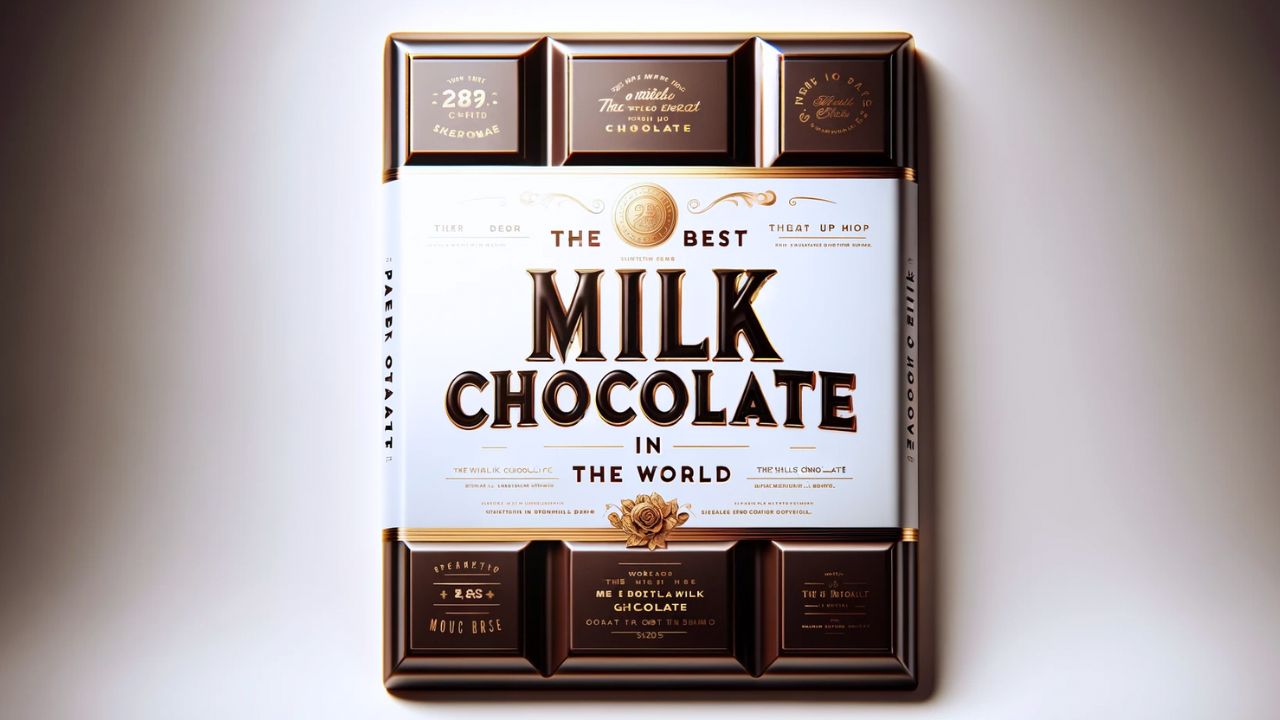
My favorite milk chocolate is Cacaosuyo Piura, it is like a hug in a bar. It’s creamy, rich, and has a velvety smoothness that melts perfectly on the tongue. The taste is a delicate balance of sweet and milky, with just a hint of vanilla that lingers pleasantly long after the last piece has disappeared. Holding a piece, I can’t help but admire its glossy finish and the way it breaks with a satisfying snap. It’s not just a treat; it’s a moment of pure, unadulterated joy. 🙂 Whether I’m savoring it slowly to brighten a dull afternoon or sharing it with friends, it’s my go-to comfort that never fails to make any moment a little sweeter.
My favorite milk chocolate has to be from a local artisan chocolatier in my town. There’s something about the smooth, creamy texture and the perfect balance of sweetness that just hits the spot every time. I stumbled upon it during a weekend market stroll, and it’s been my go-to treat for those moments when I need a little pick-me-up. The fact that it’s locally made with love and care adds an extra layer of specialness to each bite. Thanks for the post.